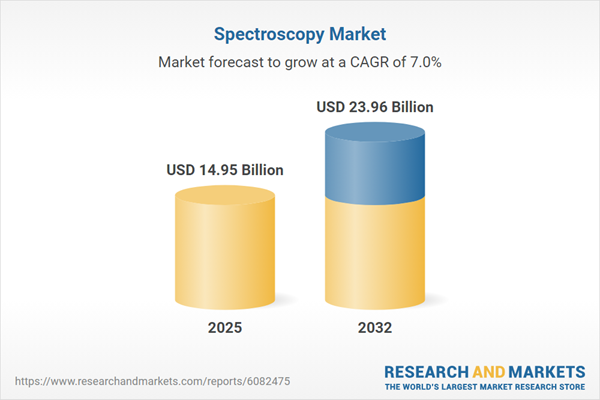Speak directly to the analyst to clarify any post sales queries you may have.
The Spectroscopy Market is redefining analytical capabilities in science and industry by enabling accurate, efficient chemical analysis across critical sectors worldwide. This report offers senior executives strategic clarity on the trends and drivers shaping the future of spectroscopy solutions.
Market Snapshot: Robust Growth and Evolving Technologies in the Spectroscopy Market
The global spectroscopy market grew from USD 13.97 billion in 2024 to USD 14.95 billion in 2025. It is projected to sustain momentum with a CAGR of 6.97%, reaching USD 23.96 billion by 2032. This trajectory reflects broad adoption of modular, high-throughput instruments and growing demand for field-ready solutions in pharmaceuticals, materials science, environmental monitoring, and petrochemicals. Advanced features—including automated sample handling and seamless integration with laboratory information management systems—are rapidly transforming laboratory workflows and expanding market boundaries.
Scope & Segmentation: Comprehensive Coverage Across Applications, Regions, and Technologies
This market research provides detailed segmentation and analysis to support stakeholder decision-making. Segments covered include:
- Product Types: Instruments, Services (Consulting and Training, Maintenance and Support), Software (Data Analysis, Instrument Control)
- Technologies: Atomic Absorption (Flame, Graphite Furnace, Hydride Generation), Infrared (Far, Mid, Near), Mass Spectrometry (Electrospray Ionization, Matrix Assisted Laser Desorption Ionization, Time Of Flight, Triple Quadrupole), Nuclear Magnetic Resonance (High Resolution, Low Resolution), Raman (Confocal, Dispersive, Fourier Transform), Ultraviolet Visible (Double Beam, Single Beam), X Ray Photoelectron
- Applications: Qualitative Analysis, Quantitative Analysis, Research and Development
- End Uses: Academic and Government Research, Chemical and Petrochemical, Environmental Testing, Food and Beverage, Pharmaceuticals and Biotechnology
- Regional Coverage: Americas (United States, Canada, Mexico, Brazil, Argentina, Chile, Colombia, Peru), Europe, Middle East & Africa (United Kingdom, Germany, France, Russia, Italy, Spain, Netherlands, Sweden, Poland, Switzerland, United Arab Emirates, Saudi Arabia, Qatar, Turkey, Israel, South Africa, Nigeria, Egypt, Kenya), Asia-Pacific (China, India, Japan, Australia, South Korea, Indonesia, Thailand, Malaysia, Singapore, Taiwan)
- Company Profiles: Thermo Fisher Scientific Inc., Agilent Technologies, Inc., Shimadzu Corporation, PerkinElmer, Inc., Bruker Corporation, Waters Corporation, Malvern Panalytical Ltd., Hitachi High-Tech Corporation, JEOL Ltd., HORIBA, Ltd.
Spectroscopy Market: Key Takeaways for Decision-Makers
- Instrument upgrades and modular sampling systems remain central to research and industrial adoption, supporting scalable, flexible analytical environments.
- Integrated AI-driven data interpretation and predictive maintenance capabilities reduce manual workloads, minimize downtime, and accelerate time to actionable results.
- Sustainability initiatives are influencing purchasing, with a preference for energy-efficient components, recyclable materials, and platforms supporting instrument lifecycle extension.
- Strategic collaborations with cloud computing providers and academic institutions foster innovation and enable scalable deployment of next-generation technologies.
- Service portfolios are expanding beyond maintenance to include training, calibration, and tailored digital support, delivering long-term value through recurring revenue streams and client retention.
- Regional market growth is driven by regulatory mandates, research funding, and public-private partnerships, ensuring a globally resilient landscape with varied adoption drivers.
Tariff Impact: Navigating Policy Risks and Supply Chain Adjustments
United States tariffs on key spectroscopic components have resulted in higher procurement costs and prompted manufacturers to seek local sourcing and vertical integration. These measures, while demanding initial investment, aim to strengthen quality control and reduce geopolitical risks. Smaller laboratories and service providers are adapting through refurbished equipment sourcing and collaborative purchasing. Overall, market participants are executing supply chain diversification strategies, exploring new suppliers, and forming procurement consortia to offset policy-driven cost pressures.
Methodology & Data Sources
The research leverages direct interviews with industry experts, laboratory managers, and procurement leaders, complemented by quantitative surveys of research and manufacturing organizations. Secondary analysis includes peer-reviewed publications, regulatory documents, conference reports, and financial disclosures. Findings are validated through cross-referencing and subject-matter peer review to ensure analytical integrity and actionable insights.
Why This Report Matters: Actionable Insights for Strategic Growth
- Guides investment and portfolio planning by clarifying evolving technology trends, application focus areas, and regulatory dynamics.
- Supports risk management and operational resiliency through supplier strategy recommendations and tariff impact analysis.
- Enables informed decisions on digital integration, service expansion, and sustainability alignment for sustainable competitive advantages.
Conclusion
Spectroscopy is enabling next-generation scientific discovery and process optimization. Strategic adaptation to evolving technologies, regional forces, and regulatory trends will position organizations for growth across the analytical landscape.
Table of Contents
3. Executive Summary
4. Market Overview
7. Cumulative Impact of Artificial Intelligence 2025
Companies Mentioned
The companies profiled in this Spectroscopy market report include:- Thermo Fisher Scientific Inc.
- Agilent Technologies, Inc.
- Shimadzu Corporation
- PerkinElmer, Inc.
- Bruker Corporation
- Waters Corporation
- Malvern Panalytical Ltd.
- Hitachi High-Tech Corporation
- JEOL Ltd.
- HORIBA, Ltd.
Table Information
| Report Attribute | Details |
|---|---|
| No. of Pages | 191 |
| Published | October 2025 |
| Forecast Period | 2025 - 2032 |
| Estimated Market Value ( USD | $ 14.95 Billion |
| Forecasted Market Value ( USD | $ 23.96 Billion |
| Compound Annual Growth Rate | 6.9% |
| Regions Covered | Global |
| No. of Companies Mentioned | 11 |









